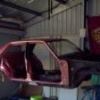
triple flow radiaters
#1

Posted 16 November 2005 - 01:53 PM
#2
 _WYLDLC 6_
_WYLDLC 6_
Posted 16 November 2005 - 04:03 PM
#3

Posted 16 November 2005 - 07:51 PM
Your water pump will push water at a certain speed at a given engine RPM,
If your radiator is a triple flow then the water will have to move thru the radiator 3x as fast as normal, encountering 3x the friction, this places 3x the stress on your water pump impeller, which in a 308 is a fairly poorly designed unit at best.
Realistically it won't help much at cruise, and is a hinderance at RPM, causing cavitation earlier than would normally be encountered.
My advice, stick with a 3 row. The radiator in a Holden V8 isn't the limiting factor, the water pump is. If you want the best radiator then fit a cross flow unit such as WB or C/dore.
Just my opinion.
#4

Posted 16 November 2005 - 10:41 PM
Edited by shanegtr, 16 November 2005 - 10:45 PM.
#5

Posted 17 November 2005 - 04:40 AM
#6
 _devilsadvocate_
_devilsadvocate_
Posted 17 November 2005 - 11:05 AM
The quote above is a little fuzzy, the water pump isnt going to suffer like described. In most systems now the water pump is moving large volumes of water courtesy of the thermostat bypass arrangements anyway.Look at it this way.....
Your water pump will push water at a certain speed at a given engine RPM,
If your radiator is a triple flow then the water will have to move thru the radiator 3x as fast as normal, encountering 3x the friction, this places 3x the stress on your water pump impeller, which in a 308 is a fairly poorly designed unit at best.
As I understand it the triple flow rad, has the coolant pass down, up and then down before it gets out of the radiator - hence triple flow. Im yet to see any reasoning as to why this can give better cooling(please dont tell me its because the water is in the radiator longer..........), from the manufacturers or otherwise.
People who purchase them reckon they are good, so in the least they are well made and of superior materials to many stock rads.
#7

Posted 17 November 2005 - 12:31 PM
#8

Posted 17 November 2005 - 02:47 PM
#9

Posted 18 November 2005 - 07:32 PM
Double pass radiators require 16x more pressure to flow the same volume of coolant through them, as compared to a single pass radiator. Triple pass radiators require 64x more pressure to maintain the same volume. Automotive water pumps are a centrifugal design, not positive displacement, so with a double pass radiator, the pressure is doubled and flow is reduced by approximately 33%. Modern radiator designs, using wide/thin cross sections tubes, seldom benefit from multiple pass configurations. The decrease in flow caused by multiple passes offsets any benefits of a high-flow water pump.
To read the whole article go to http://www.stewartco...Tech_Tips_5.htm
Without getting into an argument with anyone.....
cavitation is caused by a pump being able to discharge more than what it can suck. What happens is the liquid tha is being pumped "stretches" in the suction side(from low pressure) and creates airbubbles. Once the liquid reaches the impellor the air bubble implode due to positive pressure.
I am not arguing with your definition, but the cause is more poor design of the impeller rather than the pump being able to discharge more than what it can suck.
The quote above is a little fuzzy, the water pump isnt going to suffer like described. In most systems now the water pump is moving large volumes of water courtesy of the thermostat bypass arrangements anyway.
I didn't dispute the capacity of the pump to move volume, just its ability to push water through a radiator with much higher internal friction. Once the wheezy 308 impeller has to force water through the greater restriction its design fails it, causing the earlier cavitation. Basically what I am saying is the 308 pump is an average unit by design of its impeller, yes some are better than others but overall, compared to other manufacturers, it is poor. Forcing it to work harder by pushing water through a triple pass radiator is not a great idea.
#10

Posted 21 November 2005 - 10:50 AM
#11
 _devilsadvocate_
_devilsadvocate_
Posted 21 November 2005 - 11:47 AM
Shanegtr, the total length of the tubes may be the same, but its similar to having one third the number of tubes and each tube three times as long. This can only restrict circulation, theoretically nine times the drag through the radiator(all other things being equal), but this is not the only drag in the system..........so maybe not that type of increase overall.A triple flow radiator shouldnt create a noticable restriction to water flow as the water is still flowing throught the same amount of tubes.
All that being said, from most reports there must be something good going on inside the triple flows and standard water pumps go well with them, so let us know how you go with it.
Edited by devilsadvocate, 21 November 2005 - 11:48 AM.
#12

Posted 21 November 2005 - 01:13 PM
#13
 _jap-xu1_
_jap-xu1_
Posted 21 November 2005 - 02:08 PM
it leaked water as soon as i installed it. then the side mounting bracket fell off it
0 user(s) are reading this topic
0 members, 0 guests, 0 anonymous users





 View Garage
View Garage










